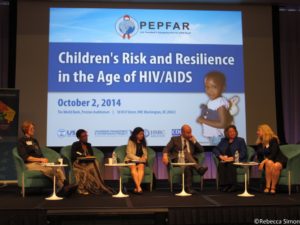
Understanding HIV impacted Children’s Risk and Resilience
 How will HIV/AIDS impact children over the long run and what can we do about it? The question was posed to 14 global experts on children, HIV/AIDS and child development by the President’s Emergency Plan for AIDS Relief (PEPFAR) and the US Agency for International Development (USAID).
How will HIV/AIDS impact children over the long run and what can we do about it? The question was posed to 14 global experts on children, HIV/AIDS and child development by the President’s Emergency Plan for AIDS Relief (PEPFAR) and the US Agency for International Development (USAID).
A three-phase study was conducted to find the answer. Phase 1 examined documented evidence of impact: health, psychological and social effects of adult HIV on children. Phase 2 examined child development literature to better understand long-term outcomes for HIV impacted children. Phase 3 developed a model to begin to help predict long-term consequences for the millions of HIV/AIDS impacted children worldwide.
All children–especially the very young–rely on adults for protection, care, developmental stimulation, nutrition and healthcare access. HIV/AIDS is most prevalent among adults in their reproductive years, resulting in far-reaching implications for children.
Adult HIV taxes the standard of care parents are able to provide for their children, especially when HIV/AIDS is coupled with poverty.
The result of this effort allows us to better understand the current state of children in the epidemic as well as to better predict the future for them and their families.
Phase 1: Risk and HIV Impacted Children. Through PEPFAR much has been learned about the implications of adult HIV for children. While risk does not necessarily lead to harm, many studies indicate it often does. Specific risk areas identified: psychological adjustment, cognitive development, nutrition, education outcomes, exposure to violence, and sexual health.
Phase 2: Long-term Outcomes of Childhood Adversity Addressed in Child Development Literature. Extensive child development evidence was used to better understand short- and long-term implications of HIV/AIDS for children, how to best protect them from harm and to mitigate harm should it occur. Specific harms identified: disruption of the parent-child relationship, parental death, parental mental health, attachment and institutional care, violence against children, growth and development.
Phase 3: Modeling the Impact of Adult HIV on Impacted Children. Based on a single cohort of women and children in South Africa the model looked at outcomes for children based on their mothers’ state of health (uninfected, HIV+ but asymptomatic, symptomatic, on treatment or deceased). Findings indicate key areas which can inform current interventions and future policy to more effectively address HIV-impacted child outcomes.
“This comprehensive research provides critical insights and measures for everyone working with HIV impacted children,” said Anita Smith, CAFI president. “Clearly a focus on family-centered care, support and interventions is critical while more long-term research continues.”
All session presentations are available for viewing at www.OVCsupport.net.


